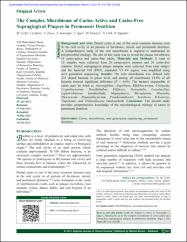| dc.contributor.author | Çelik, Z. | |
| dc.contributor.author | Cakiris, A. | |
| dc.contributor.author | Abacı, N. | |
| dc.contributor.author | Yanıkoğlu, Funda | |
| dc.contributor.author | Ilgın, Can | |
| dc.contributor.author | Ekmekçi, S. | |
| dc.contributor.author | Çelik, H. | |
| dc.contributor.author | Tağtekin, D. | |
| dc.date.accessioned | 2022-03-09T11:34:06Z | |
| dc.date.available | 2022-03-09T11:34:06Z | |
| dc.date.issued | 2021 | en_US |
| dc.identifier.citation | Celik, Z. C., Cakiris, A., Abaci, N., Yaniikoglu, F., Ilgin, C., Ekmekci, S. S., Celik, H., & Tagtekin, D. (2021). The complex microbiome of caries-active and caries-free supragingival plaques in permanent dentition. Nigerian journal of clinical practice, 24(10), 1535–1540. DOI: https://doi.org/10.4103/njcp.njcp_49_21 | en_US |
| dc.identifier.issn | 1119-3077 | |
| dc.identifier.uri | https://doi.org/10.4103/njcp.njcp_49_21 | |
| dc.identifier.uri | https://hdl.handle.net/20.500.12780/474 | |
| dc.description.abstract | Abstract
Background and aim: Dental caries is one of the most common diseases seen in the oral cavity in all periods of deciduous, mixed, and permanent dentition. A comprehensive study of the oral microbiome is required to understand its polymicrobial etiology. The aim of this study was to reveal the plaque microbiome of caries-active and caries-free adults.
Materials and methods: A total of 52 samples were collected from 26 caries-active patients and 26 caries-free controls. Dental supragingival plaque samples were collected from each subject and the bacterial 16S rDNA, expanded V3-V4 region, was amplified using next generation sequencing.
Results: The core microbiome was defined with 235 shared bacteria in genus level, and among all microbiome 14.8% of all bacteria showed significant difference (P < 0.05). The bacteria responsible of caries may be listed as Anaeroglobus, Atopobium, Bifidobacterium, Centipeda, Cryptobacterium, Desulfobulbus, Filifactor, Howardella, Lactobacillus, Leptotrichiaceae (unclassified), Megasphaera, Mycoplasma, Olsenella, Phocaeicola, Propionibacterium, Pseudoramibacter, Scardovia, Schwartzia, Treponema, and Veillonellaceae (unclassified).
Conclusion: The present study provides comprehensive knowledge of the microbiological etiology of caries in permanent dentition. | en_US |
| dc.language.iso | eng | en_US |
| dc.publisher | Wolters Kluwer | en_US |
| dc.relation.isversionof | https://doi.org/10.4103/njcp.njcp_49_21 | en_US |
| dc.rights | info:eu-repo/semantics/openAccess | en_US |
| dc.subject | Caries | en_US |
| dc.subject | Microbiome | en_US |
| dc.subject | Next generation sequencing | en_US |
| dc.subject | Permanent dentition | en_US |
| dc.title | The complex microbiome of caries-active and caries-free supragingival plaques in permanent dentition | en_US |
| dc.type | article | en_US |
| dc.contributor.department | İstanbul Kent Üniversitesi, Fakülteler, Diş Hekimliği Fakültesi, Klinik Bilimler Bölümü | en_US |
| dc.contributor.institutionauthor | Yanıkoğlu, Funda | |
| dc.identifier.volume | 24 | en_US |
| dc.identifier.issue | 10 | en_US |
| dc.identifier.startpage | 1535 | en_US |
| dc.identifier.endpage | 1540 | en_US |
| dc.relation.journal | Nigerian Journal of Clinical Practice | en_US |
| dc.relation.publicationcategory | Makale - Uluslararası Hakemli Dergi - Kurum Öğretim Elemanı | en_US |


















